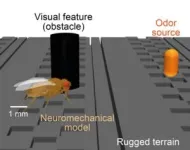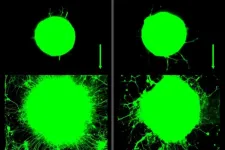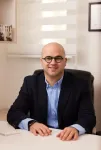(Press-News.org)
All animals, large or small, have to move at an incredible precision to interact with the world. Understanding how the brain controls movement is a fundamental question in neuroscience. For larger animals, this is challenging because of the complexity of their brains and nervous systems. But the fruit fly, Drosophila melanogaster, has a smaller and therefore more easily mappable brain, allowing scientists to gain detailed insights into how its nervous system drives behavior.
To understand how the nervous system controls actions, researchers at the group of Pavan Ramdya at EPFL created a simulated reality where a virtual fly can operate and respond the way real flies do. This program, known as NeuroMechFly v2, implements a neuromechanical model that goes beyond basic motor functions. By incorporating visual and olfactory sensing, complex terrains, and fine motor feedback, NeuroMechFly v2 simulates how a fruit fly would navigate through its environment while reacting to sights, smells, and obstacles.
Ramdya’s research has focused on digitally replicating the principles underlying Drosophila motor control. In 2019, his group published DeepFly3D, a software that uses deep learning to capture how fly’s legs move based on images from multiple cameras. In 2021, Ramdya’s team revealed LiftPose3D, a method for reconstructing 3D animal poses from images taken from a single camera. These efforts were complemented by his 2022 publication of NeuroMechFly, a first morphologically accurate digital “twin” of Drosophila.
With the second iteration of NeuroMechFly, the researchers have now added detailed features that mimic real fly anatomy and physiology. For example, they carefully updated the leg and joint angles to better match the biomechanics of real fruit fly movements. The model’s “brain” can now process visual and olfactory information through virtual eyes and antennae, giving it a sensory experience close to that of an actual fruit fly.
This setup lets NeuroMechFly v2 simulate different control strategies for real-life tasks such as walking over rough terrain or turning in response to smells and visual cues. The team has demonstrated realistic fly behavior under different conditions. For instance, the model can track a moving object visually or navigate towards an odor source, while avoiding obstacles in its path.
NeuroMechFly also allows researchers to infer neural activities in the brain based on the fly’s experience in the virtual world. “By interfacing NeuroMechFly v2 with a recently published computational model of the fly’s visual system, researchers can read out not only what the fly is seeing in the simulated environment, but also how real neurons might be responding,” says Sibo Wang-Chen, who led the research.
With access to these neural activities, the scientists modelled how the fly might chase another fly—for example, during courtship—in a biologically plausible way. This was possible due to the hierarchical control system in the model, which lets higher-level “brain” functions interact with the lower-level motor functions—an organization that mimics how real animals process sensory input and control their bodies.
Finally, researchers can also use NeuroMechFly v2 to study how the brain integrates sensory signals to maintain an awareness of the animal’s state. To demonstrate this, Ramdya’s team replicated the fly’s ability to use feedback signals from leg movements to keep track of its location—a behavior called path integration. This feature allows the simulated fly to “know” where it is, even when its visual inputs are limited. This kind of closed-loop sensory processing is a hallmark of biological intelligence and a critical milestone for neuroengineering.
Taken together, NeuroMechFly v2 enables researchers to investigate how the brain controls crucial behaviors using computational models. This paves the way for deeper insights into brain-body coordination, especially for species with complex sensory-motor systems. In the future, this model could serve as a blueprint for designing robots that navigate using sensory cues, such as tracking odors or adjusting movements to stabilize visuals, like real animals exploring their environments.
By improving machine learning models that control these simulations, researchers can also learn how animal intelligence can pave the way for AI systems that are more autonomous, robust, and responsive to their surroundings.
Other contributors
EPFL Biorobotics Laboratory
Reference
Wang-Chen, S., Stimpfling, V. A., Lam, T. K. C., Özdil, P. G., Genoud, L., Hurtak, F., & Ramdya, P. (2024). NeuroMechFly v2: simulating embodied sensorimotor control in adult Drosophila. Nature Methods 12 November 2024. DOI: 10.1038/s41592-024-02497-y
END
Researchers have found evidence that mangrove forests – which protect tropical and subtropical coastlines – are drowning in the Maldives.
Their findings, published today (Tuesday 12 December) in Scientific Reports, indicate that rising sea level and a climate phenomenon known as the Indian Ocean Dipole have led to some Maldivian islands losing over half of their mangrove cover since 2020.
The research team, led by Northumbria University, warn that the findings have implications not only for the Maldives, but also for other island nations and coastal ecosystems around the world.
In 2020, more than a quarter of the Maldivian islands containing mangrove forests saw their trees experiencing ...
There’s no doubt that exercise does a body good. Regular activity not only strengthens muscles but can bolster our bones, blood vessels, and immune system.
Now, MIT engineers have found that exercise can also have benefits at the level of individual neurons. They observed that when muscles contract during exercise, they release a soup of biochemical signals called myokines. In the presence of these muscle-generated signals, neurons grew four times farther compared to neurons that were not exposed to myokines. These cellular-level experiments suggest that exercise can have a significant biochemical effect on nerve growth.
Surprisingly, the researchers also ...
A new paper in Nicotine and Tobacco Research, published by Oxford University Press, finds that people who switch from smoking cigarettes to vaping see improved respiratory health, but people who begin consuming electronic cigarettes while continuing to smoke regular cigarettes do not report improved respiratory symptoms.
Adults increasingly use electronic cigarettes to try to quit smoking because of the perceived reduced risk. But while vaping reduces exposure to toxic chemicals, it has been unclear whether switching from cigarettes to e-cigarettes results in a reduction of the respiratory problems—like wheezing and coughing—common in regular cigarette ...
Boston, Massachusetts, 12 November 2024 – Environmental exposure to air pollutants during critical developmental periods may significantly impact autism risk, according to a groundbreaking Emerging Topic review published 12 November 2024, in Brain Medicine. The study reveals how common air pollutants, including fine particulate matter and nitrogen oxides, can trigger complex biological cascades affecting brain development.
"Different kinds of neurological disorders, including autism spectrum disorder, can be associated ...
Boston, Massachusetts, 12 November 2024 – The complex interplay between nitric oxide and brain disorders takes center stage in the latest Genomic Press Interview, published November 12, 2024, in Brain Medicine. Professor Haitham Amal, head of the Laboratory of Neuromics, Cell Signaling, and Translational Medicine at the Hebrew University of Jerusalem, shares insights into his groundbreaking research and personal motivation.
“Meeting families and children with autism in Boston during my time at MIT inspired me to focus on a single goal: to help develop biological diagnostics ...
Destructive winds during storms and cyclones often cause tree failures, especially through uprooting and stem breakage. However, how trees respond to wind under various forest configurations and weather conditions remains unclear. A recent study on Cryptomeria japonica plots shows that trees dissipate wind energy by switching between two swaying behaviors at specific wind speeds, offering insights that may help in improved forest management to minimize damage caused by storms.
Extreme weather events, such as tropical and extratropical cyclones and tornadoes, can cause widespread damage to forests, leading to environmental and financial ...
Bioprinting is a technology used to create three-dimensional structures, such as human tissues or organs, using bio-inks made of cells and hydrogels. However, conventional inkjet technology has difficulty dispensing bio-inks that are sensitive to temperature due to the heat generated during operation. Furthermore, conventional 3D bioprinting mainly utilizes simple syringe-type printing devices with a single needle, making it time-consuming to produce artificial organs like the brain, lungs, and heart.
The Bionics Research Center team, led by Dr. Byung Chul Lee at the Korea Institute of Science and Technology (KIST, President Sang-Rok Oh), in ...
La version française suit
Opioid use disorder: updated clinical practice guideline
An updated evidence-based guideline aimed at helping clinicians and other health care providers manage patients with opioid use disorder recommends buprenorphine and methadone as first-line treatments. The guideline is published in CMAJ (Canadian Medical Association Journal). https://www.cmaj.ca/lookup/doi/10.1503/cmaj.241173
Opioid use and opioid use disorder are the leading causes of drug-related deaths worldwide, and Canada ...
The rapid advancement in personalized healthcare has driven the development of wearable biomedical devices for real-time biomarker monitoring and diagnosis. Traditional invasive blood-based diagnostics are painful and limited to sporadic health snapshots. To address these limitations, microneedle-based sensing platforms have emerged, utilizing interstitial fluid (ISF) as an alternative biofluid for continuous health monitoring in a minimally invasive and painless manner.
The team led by Wei Gao from California Institute of Technology providea a comprehensive overview of microneedle sensor technology, covering microneedle design, fabrication methods, ...
Research by scientists at the University of Sydney has identified a constituent in the cannabis plant that improves sleep.
Their report is the first to use objective measures to show the component, known as cannabinol (CBN), increases sleep in rats.
The study has been published in the leading journal Neuropsychopharmacology.
“For decades, cannabis folklore has suggested that aged cannabis makes consumers sleepy via the build-up of CBN, however there was no convincing evidence for this,” said lead author on the study Professor Jonathon Arnold, ...










